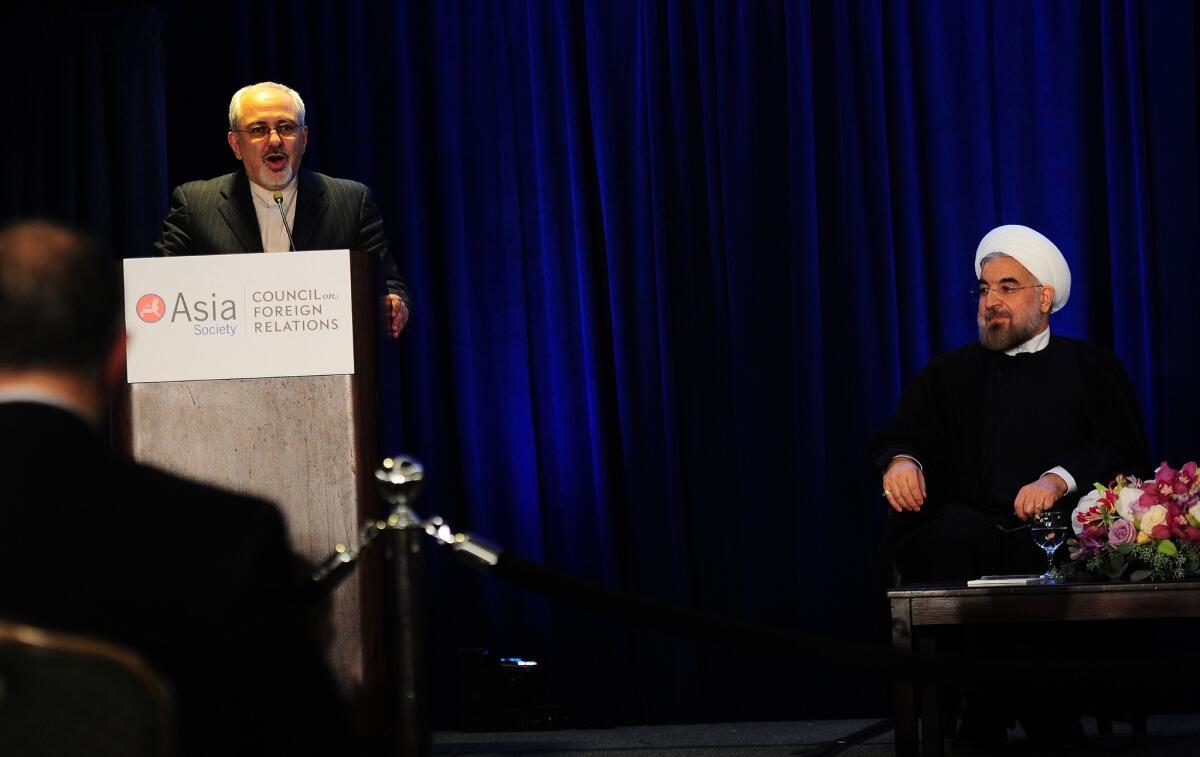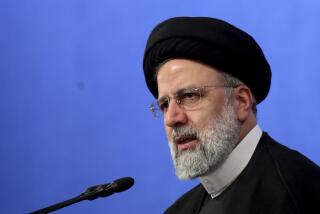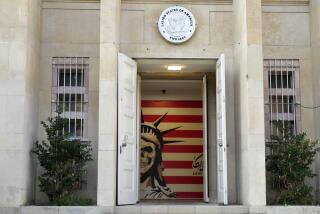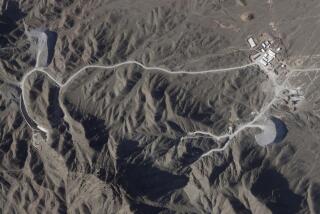Obstacles to Iran nuclear deal: Secrets, lies, political infighting

Iran and six major powers have been at odds for a decade over the Islamic republic’s development of nuclear capabilities, at the heart of negotiations set to resume Tuesday in Geneva.
Hopes of budging the high-stakes diplomatic standoff from impasse have been raised by the conciliatory words of Iran’s recently inaugurated President Hassan Rouhani. But many in the West point out that Iran has yet to match its hopeful promises with verifiable deeds to show its nuclear programs aren’t aimed at building atomic weapons.
David Albright, a physicist and founder of the nonprofit Institute for Science and International Security, told the U.S. Senate Foreign Relations Committee earlier this month that Iran’s nuclear industry investments “often made in secret and dominated by black market purchases, have not been consistent with a strictly peaceful nuclear program.”
Here is an overview of Iran’s suspect facilities, enriched uranium stockpiles and the political posturing that has led to uneven compliance with International Atomic Energy Agency inspections and doubts in Tehran and Washington that leaders can deliver on a deal even if one is reached.
Facilities:
Fordow Fuel Enrichment Plant
Iran built the site where it enriches uranium in secret, beginning in 2007, according to the IAEA, which learned of it two years later when President Obama and his French and British counterparts presented evidence obtained from independent satellite monitoring and exile reports. The facility was designed to hold about 3,000 centrifuges and was believed to have achieved full capacity earlier this year. Its two main enrichment halls are built into a mountainside and considered invulnerable to destruction by conventional airstrikes. The United States and its allies – Israel in particular, due to its location within Iranian missile range – have expressed concern that Tehran has located enrichment activity underground to allow it to evade detection, should it decide to accelerate highly enriched uranium output for weapons.
Natanz Pilot Fuel Enrichment Plant
Iran has increased the capacity of the Natanz facility to house more than 15,000 centrifuges, including more than 1,000 IR-2m models capable of more efficient processing of the type needed for weapons-grade uranium. The buildup occurred as Iran informed the IAEA two years ago that the plant, another underground facility, though not as deeply buried as Fordow, will be producing low enriched uranium (LEU) to a purity of 3.5%; the high enrichment activity will be conducted at Fordow.
Arak heavy water reactor
Analysts describe the facility southwest of Tehran as better suited to making plutonium for nuclear weapons than its stated purpose of producing medical isotopes, for which the Tehran Research Reactor is judged sufficient to meet the country’s needs. Commissioning of the Arak reactor has been delayed to about mid-2014 by sanctions-induced complications in importing some equipment. The Arak facility, intended to produce plutonium, would also give Iran a second fuel, in addition to highly enriched uranium, to power nuclear weapons.
Parchin military site
Suspected of housing a high-explosive testing chamber and related facilities, the Parchin military base has undergone major “sanitizing,” according to Institute for Science and International Security interpretation of satellite imagery, which shows buildings have been razed and soil bulldozed and carried away. While IAEA inspectors were allowed limited access to the base in recent years, they were not permitted to take soil samples or visit areas of the base where prohibited nuclear weapons testing is suspected of having been carried out. Western nations’ fears are that evidence of any bomb testing in violation of the Nuclear Nonproliferation Treaty has been removed. If so, Tehran’s pledge of better “transparency” for United Nations inspectors would do nothing to alleviate concerns about Iran’s ability to clandestinely build and test atomic weapons.
Esfahan fuel fabrication facilities
Iran operates three small research reactors, built with Chinese assistance, and a Fuel Fabrication Laboratory that converts uranium to fuel pellets. Esfahan also houses Iran’s largest missile-production facility, also built with help from China and North Korea, according to Albright’s institute.
Uranium stockpiles:
According to the IAEA safeguards report in August, Iran has produced 9,704 kilograms of 3.5% uranium, 2,877 kilograms of which has been further enriched at Natanz and Fordow to produce 373 kilograms of near 20% LEU. As of August, the IAEA reported, Iran held 186 kilograms of near 20% LEU, having converted the rest of its stockpile to fuel rods for a medical research reactor.
In Albright’s Senate testimony, he noted that Iran “has been careful to convert sufficient 20% LEU to keep its stockpile below 240-250 kg, the amount considered necessary to produce enough weapons-grade uranium to build a nuclear weapon and the “red line” drawn by Israeli Prime Minister Benjamin Netanyahu.
If Iran decided to ramp up enrichment clandestinely, it could achieve “critical capability” by mid-2014, Albright testified.
Politics:
At the IAEA’s annual board of governors meeting in Vienna last month, the director-general reported that no progress had been made since the previous year’s decision that Iranian cooperation with agency requests for information about Iranian facilities and unfettered access to them was necessary “to restore international confidence in the exclusively peaceful nature of Iran’s nuclear program.”
The IAEA report was prepared, however, prior to Rouhani’s transfer of responsibility for nuclear negotiations to his government from the traditional purview of supreme leader Ayatollah Ali Khamenei and Rouhani’s pledge at the U.N. General Assembly to do what is necessary to conclude a nuclear deal.
The new tone in Iranian diplomacy has yet to produce concrete change in its nuclear posture, and the combative and evasive legacy of Rouhani’s predecessor, Mahmoud Ahmadinejad, remains to be overcome.
Iran said in mid-2011 that Fordow would be equipped with advanced centrifuges, which intensified concerns that the proposed investment in highly efficient enrichment signaled an intent to produce weapons-grade fuel. Tehran also said the previous year that it was starting work on a third uranium-enrichment facility, further elevating concerns that additional processing of 20% LEU would only be necessary for a weapons program.
Rouhani’s declaration at the U.N. General Assembly last month that Iran has never pursued nuclear weapons contradicted the 2007 U.S. National Intelligence Estimate, which concluded with “high confidence” that until 2003 the Iranian military was working on nuclear weapons at the government’s direction. That has done little to persuade skeptics that Iran is being honest about its nuclear activities. The U.S. assessment, however, conceded that there was no evidence in 2007 that Tehran had resumed pursuit of nuclear weapons.
In March 2007, when Ahmadinejad appeared to relish provoking Israel and the West, Tehran began denying access to U.N. nuclear inspectors except when unquestionably required by the nonproliferation treaty. Tehran also took the position that it wasn’t obliged to inform the IAEA of nuclear facility construction until there was fissionable material delivered to the plants, compounding an impression that it was clandestinely expanding its nuclear repertoire to include weapons.
Delivering on a deal:
Any agreement to curtail uranium enrichment in exchange for sanctions relief would have to be approved by Khamenei in Iran, as well as by the U.S. Congress.
Khamenei has deemed nuclear weapons a contradiction of Islamic values and publicly backed Rouhani‘s call for a nuclear accord with the six global powers. But conservative forces within the Islamic Revolutionary Guard Corps have warned against any accommodation of the West, hinting that they would torpedo any deal perceived as sacrificing Iranian sovereignty or strategic assets.
Obama likewise faces powerful opposition in the U.S. House of Representatives, which overwhelmingly passed a new round of sanctions on Iran in July that, if approved by the Senate, would strip Iran of 80% of its revenue by blocking oil exports. Congressional approval would be necessary to lift existing sanctions on Iran, which could become another political football in the bitterly divided Congress.
Israel’s Netanyahu has also signaled grave doubts about Iran’s new negotiating stance, calling Rouhani a “wolf in sheep’s clothing” and vowing to go it alone, if necessary, to strike Iranian nuclear facilities before Tehran acquires a nuclear bomb. Netanyahu reiterated Monday that sanctions should be maintained to keep the pressure on Iran to cease all uranium enrichment.
ALSO:
Hundreds arrested in Moscow anti-migrant riots
3 Americans win Nobel Prize in Economic Sciences
Syria says civilians evacuated from Damascus suburb
Twitter: @cjwilliamslat
More to Read
Start your day right
Sign up for Essential California for news, features and recommendations from the L.A. Times and beyond in your inbox six days a week.
You may occasionally receive promotional content from the Los Angeles Times.







